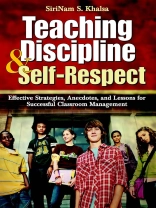Manage your classroom with proven, positive techniques that promote appropriate behavior.
Teachers want to be able to teach the content they were trained to teach. Yet most teachers find themselves faced with the challenge of achieving effective classroom management. Highly readable and engaging, Teaching Discipline & Self-Respect offers guidelines, specific strategies, and structured activities that have been used successfully in culturally, linguistically, economically, and academically diverse classrooms.
Siri Nam S. Khalsa, a master teacher and consultant who is passionate about teaching and understanding the individual needs of every student, focuses on developing self-esteem and self-image while maintaining the dignity of each student. Through vignettes and case studies, Khalsa′s text provides readers with:
- Guidelines for changing students′ negative behavior
- Reproducible lessons, such as ‘Understanding Anger’ and ‘Teaching ′I′ and ′You′ Statements’
- Engaging activities ready for immediate use in difficult situations
- 15 steps to help teachers keep a positive mental attitude
- 30 techniques for reducing stress and maintaining perspective when working with challenging students
This refreshing and energizing approach to classroom management shows teachers how to embrace positive change and improve both their teaching practice and their students′ lives.
Cuprins
Foreword by Jeffrey R. Ryan
Acknowledgments
About the Author
Introduction: About This Book
The Boatman and the Passenger
What Is Teaching Discipline and Self-Respect?
Outcomes of Teaching Discipline and Self-Respect
Chapter Organization
1. Building Cooperation and a Community of Learners
The Heart of an Eagle
Rapport: The Power of Relationships
Outcomes of Establishing Rapport
How to Develop Rapport
Techniques for Creating Dialogue
Strategies for Creating Cooperation
Building a Community of Learners
2. Creating Classroom Procedures and Routines
Changing Behavior Cycles
Discipline Versus Punishment
Alternatives to Punishment
Classroom Procedures and Routines
Teaching Classroom Procedures and Routines
Steps for Teaching Procedures and Routines
Thinking Signs
Follow-Up Feedback
3. Teaching Discipline and Self-Respect
Who′s in Charge? Establishing Authority
Promoting Desirable Behavior
Promoting Desirable Behavior Outside the Classroom
Inviting Cooperation
Scenarios for Creating Cooperation in the Classroom
Offering Choices–Within Limits
Academic Choice
Avoiding Power Struggles
Setting Limits Through Thinking Words
The Criticism Trap
4. Strategies Impacting Positive Discipline and Self-Respect
Time Out
Repeating
Redirecting
Momentum
Self-Monitoring Checklist
Self-Control Cards
Staying in the Present
Collaborative Teaming: Many Heads Are Better Than One
5. Changing Eleven Negative Behavior Cycles
1. The Class Bully
2. The Class Clown
3. The Interrupter
4. The Disorganized Student
5. The Overly Sensitive Student
6. The Teaser
7. The Property Destroyer
8. The Fighter
9. The Student Who Feels Stupid
10. The Nervous Student
11. The Student Who Makes Sexual Overtones
6. Understanding Diverse Students and Difficult Circumstances
Working With Students and Families Who Are Disadvantaged
Scenarios for Responding to Events: Internal Voices
Understanding Culture and Linguistic Differences
ADHD: A Mistaken Disorder
Enhancing the Potential of All Students
7. Managing Your Stress: Help for Educators
Avoiding Burnout
Maintaining a Positive Mental Attitude: 15 Steps
Releasing Stress
Concluding Thoughts
References
Index












